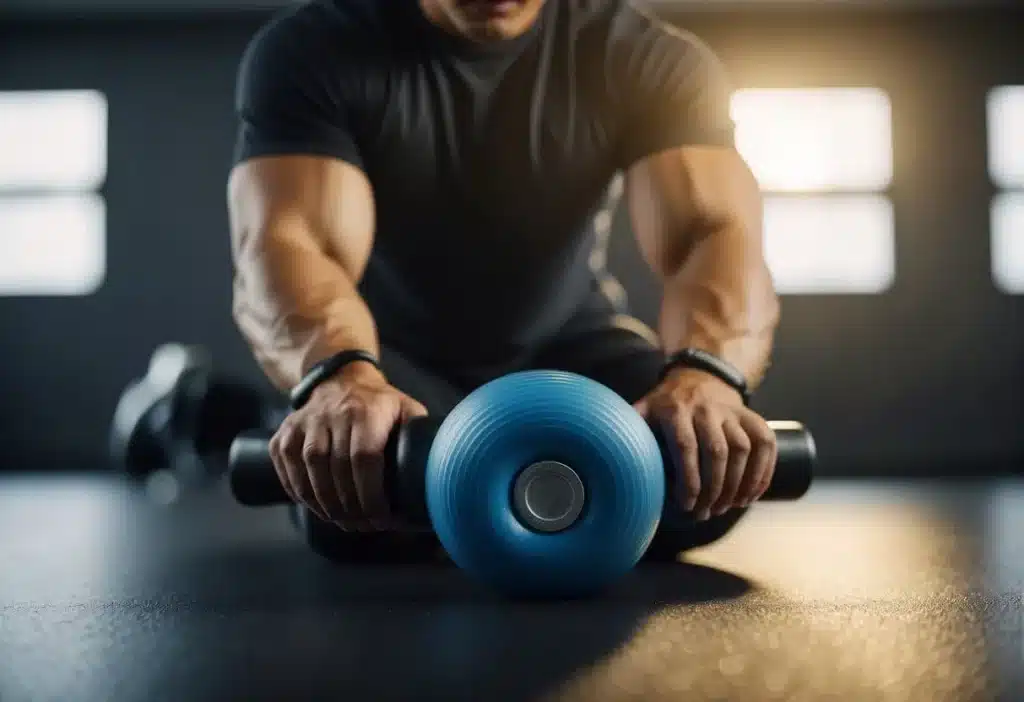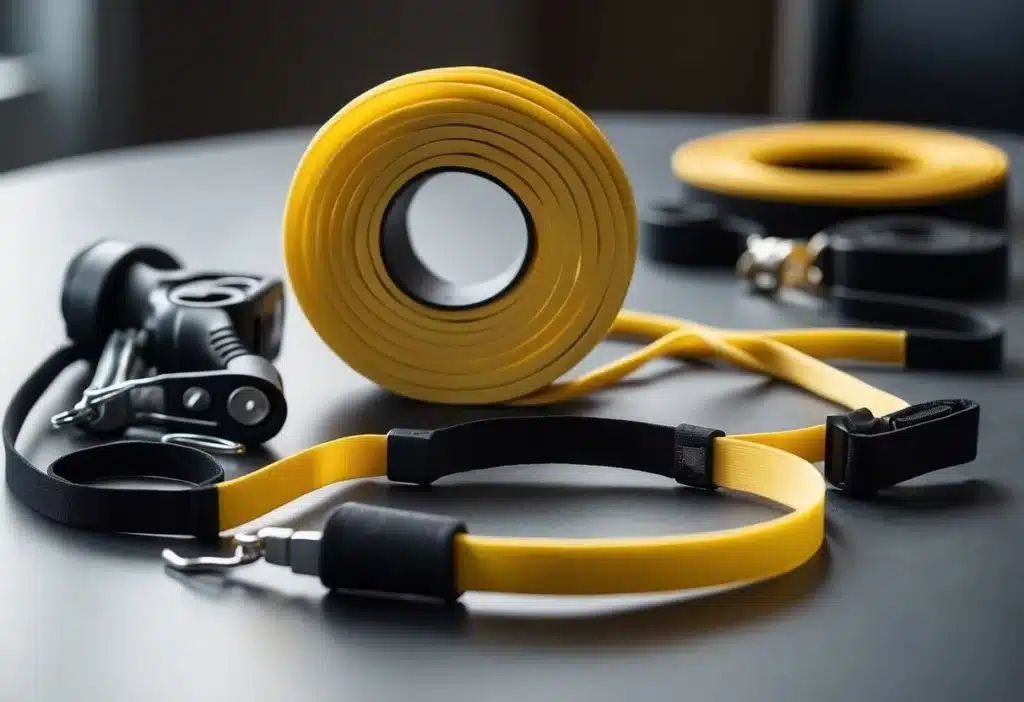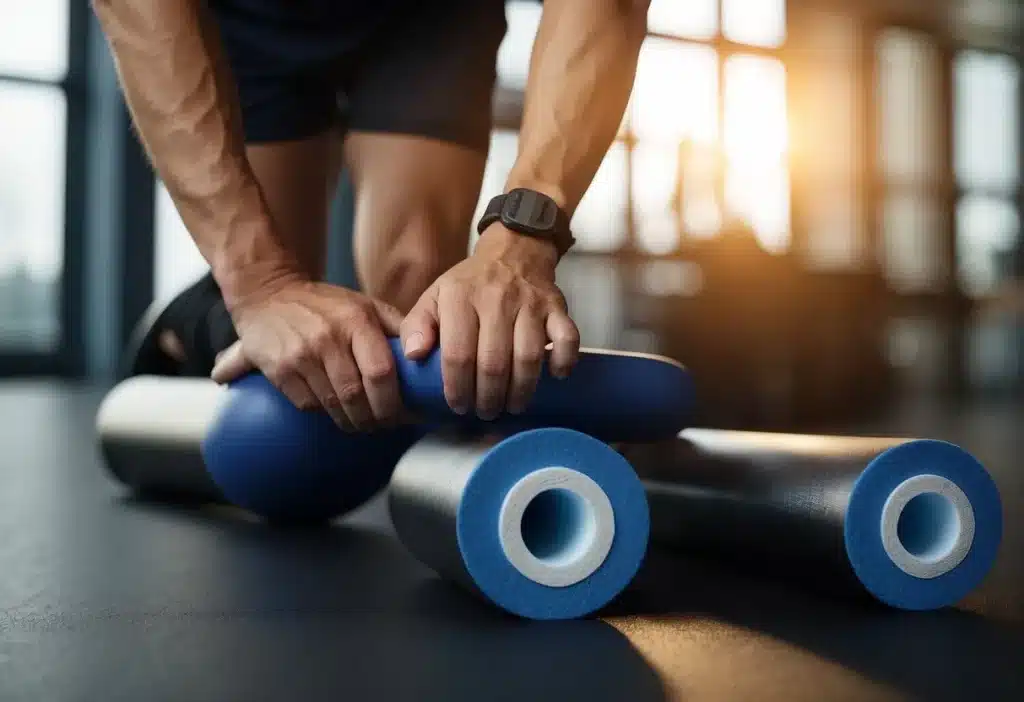Last Updated on April 16, 2024
The iliotibial band, commonly known as the IT band, can significantly contribute to pain on the lateral side, or the outside of the knee. The pain is generally located just above the knee joint in the thick connective tissue. IT band pain is common among athletes, including runners and cyclists.
Stretches that target the IT band can alleviate discomfort and improve flexibility, ultimately contributing to a reduction in IT band syndrome pain.
Let’s take a moment to identify which stretches will be most effective for relieving tightness and promoting muscle balance around the knee.
These stretches can be done in standing or seated positions. Some of these stretches can be performed with the use of additional equipment such as bands or straps. Take your time and find what works right for your body.
Implementing a consistent stretching routine, complemented by strengthening exercises, will play a vital role in supporting IT band health and preventing future injuries.
Key Takeaways
- Proper stretching is vital for reducing IT band knee pain and improving flexibility.
- A variety of effective IT band stretches can be tailored to individual needs.
- Consistent stretching and strengthening routines support your overall health.
Understanding IT Band Syndrome
The IT Band, a strong lateral knee stabilizer is also prone to overuse injuries. It plays a significant role in the stabilization of the knee while performing activities like running and cycling. When Iliotibial Band Syndrome arises the symptoms of pain are found primarily around the knee and hip areas.
Anatomy of the IT Band
The IT Band, or Iliotibial Band, is a thick band of fibrous tissue that runs along the outside of the leg from the hip to just below the knee. It aids in the stabilization of the knee.
This connective tissue attaches muscles in the hip area, including the tensor fasciae latae, to the tibia bone in the lower leg.

Causes and Symptoms of IT Band Syndrome
Iliotibial Band Syndrome (ITBS) often manifests with pain on the lateral side of the knee and into the lower thigh. This is typically exacerbated by repetitive activities such as running or cycling.
Common causes of IT band syndrome.:
- Overuse, leads to tightness and friction
- Incorrect running form or improper bike fit
- Muscle imbalances or weaknesses, particularly in the hip and core
Symptoms of ITBS include:
- Stinging sensation on the outside of the knee joint
- Swelling or thickening of the tissue in the area where the band moves over the femur
- Pain during activity, often worsening when continuing the activity
Impact on Runners and Cyclists
ITB Syndrome is also known as a runner’s knee. It is a common source of lateral knee pain.
The repetitive flexion and extension of the knee in these sports can lead to increased tension and inflammation of the IT Band.
This syndrome can significantly reduce performance and limit training time. Due to the repetitive nature of the pain and the fact that it gets worse while training, it can hinder race performance and destroy training routines.
Treatment typically involves rest, targeted stretches, and strength training exercises to address underlying muscular imbalances. Of course, acupuncture, massage, and chiropractic adjustments can all improve recovery times.
Fundamental Stretches for the IT Band
These fundamental stretches target the IT band, a ligament that runs along the outside of the leg from the hip to the tibia, helping to alleviate tightness and reduce discomfort.
Standing IT Band Stretch
In a standing position, cross the left leg behind the right and lean to the right side, extending the left arm overhead.
This movement creates a gentle pull along the outer thigh from the hip to the knee.
Hold for 20-30 seconds, then switch to stretch the right leg.
Repeat 2-4 times
Seated IT Band Stretch
While seated on the floor, extend your legs forward.
Cross the right foot over the left leg, placing the foot flat on the floor.
Twist the torso to the right, pushing against the right thigh with the left elbow. This position encourages stretching of the IT band and gluteal muscles.
Maintain the stretch for 20-30 seconds and repeat on the opposite side.
Floor-Based IT Band Stretches
Lying on the back, cross the right leg over the left and move both legs more to the left side, ensuring the right foot is touching the ground.
This facilitates a deep stretch along the right IT band and hip.
Similarly, yoga poses like the “pigeon pose” can be incorporated into routines to further promote flexibility and stability in the hips.
Repeat the stretch for the left leg after holding the right side for 20-30 seconds.
Strengthening Exercises for IT Band Support
Effective IT band support hinges on targeted strengthening exercises that focus on hip and thigh stability, core engagement, and gluteal strength.
These exercises aim to correct muscle weakness and address muscular imbalances that are often associated with IT band issues.
Hip and Thigh Strengthening
The hip and thigh muscles, including the gluteus medius, tensor fasciae latae, and the quadriceps, play a pivotal role in stabilizing the iliotibial band.
A physical therapist or chiropractor may recommend exercises that specifically strengthen these areas.
- Clamshells: While lying on one side, with hips and knees stacked and bent at a 45-degree angle, keep feet together and raise the top knee. Slowly return to the starting position. Repeat 10 times with control. This is one set. Remember to work both sides.
- Side Leg Raises: While lying on one side, keep the body in a straight line and lift the top leg upward, keeping the foot in a neutral position. Slowly return to the starting position. Repeat 10 times with control. This is one set. Remember to work both sides.
A study found no strength difference in the hip abductors between individuals with ITBS and controls, but focused strengthening can still benefit those experiencing IT band discomfort.
Core and Gluteal Muscles Workouts
Core and gluteus maximus engagement is essential for maintaining pelvic stability and proper lower limb alignment, which can alleviate stress on the IT band.
- Bridges: While lying on your back with knees bent and feet flat on the ground lift the hips to create a straight line from the shoulders to the knees. Hold for 10 seconds, return to the floor, and then repeat.
- Planks: Assume the push-up position on your forearms and toes. Breathe deeply, keep the body in a straight line and hold the position to strengthen the entire core. You can practice holding for 15-30 seconds if you are new to planks.
Incorporating balance into the workouts engages the stabilizing muscles around the ankle and corrects imbalance throughout the legs.
Single-leg exercises, such as one-legged squats or deadlifts, can bolster the glutes and improve stability in both the right foot and the left foot.
It’s important that individuals perform exercises that are suitable for their fitness level and do not cause pain.
Consulting with a clinician trained in sports medicine can ensure that the selected exercises effectively support the IT band and contribute to overall lower body health and balance.

Incorporating Tools and Accessories
To enhance the effectiveness of IT band stretches, incorporating specialized tools and accessories can provide targeted myofascial release and increase the flexibility of the IT band.
Utilizing Foam Rollers for IT Band
Foam rolling is a self-myofascial release technique that applies pressure to specific points on the body to aid in the recovery of muscles and assist in returning them to normal function.
To use a foam roller for IT band relief:
- Position the foam roller under the outside of the thigh just below the hip.
- Support your weight with your forearms and the opposite leg placed on the floor for balance.
- Gently roll down from the hip to just above the knee and back, focusing on areas of tension.
Tip: Spend extra time on sore spots but avoid rolling over the knee joint.
Using Resistance Bands for Stretching
Resistance bands can be used to add tension to stretching routines, helping to improve flexibility and strength in the IT band.
To incorporate a resistance band in IT band stretches:
- Loop a resistance band around a sturdy object and the other end just above the ankle on the leg to be stretched.
- Rotate the body away from the sturdy object until a stretch is felt along the side of the thigh.
- Hold the stretch for 20 to 30 seconds, being mindful not to cause pain.
Recovery and Treatment Strategies
In addressing recovery and treatment strategies for iliotibial (IT) band syndrome, emphasis is placed on proper rest, managing inflammation, and seeking professional guidance to facilitate healing and prevent further injury.
Proper Rest and Recovery Protocols
Rest is a critical component in the treatment of IT band syndrome. It helps to reduce ongoing irritation and allows inflammation to subside.
Ice therapy can be immensely beneficial for managing pain and reducing inflammation.
The application of ice packs to the affected area for short periods several times a day can reduce local inflammation.
Proper rest does not imply total inactivity; rather, it can include low-impact activities that do not exacerbate symptoms.
When to Consult a Doctor or Physical Therapist
When experiencing persistent IT band pain or if improvements are not observed with home treatment, one should consult a sports medicine clinician. This may be a chiropractor, an acupuncturist, or a physical therapist.
These health professionals can diagnose IT band syndrome accurately and provide personalized treatment plans.
They may recommend therapeutic exercises aimed at strengthening and stretching the IT band and associated muscles.
If the pain becomes severe, hinders daily activities, or is accompanied by swelling that does not improve with rest and ice, professional medical advice is imperative to address the issue and promote recovery.
Lifestyle Considerations for Preventing IT Band Issues
Preventing IT Band issues requires attention to various lifestyle aspects. The choice of proper footwear and the role of diet and nutrition are particularly important. These considerations can significantly impact the health of runners, providing a foundation for reducing the risk of IT Band injuries.
Importance of Proper Footwear
Runners know that choosing the right footwear is not just a matter of comfort—it’s a critical component in preventing IT Band issues. Proper footwear provides the necessary support, helping to maintain foot alignment and absorbing the shock of repetitive footfalls.
- Foot Arch Support: Shoes should match the runner’s arch type, whether it be flat, neutral, or high-arched.
| Arch Type | Recommended Support |
| Flat | Motion-control |
| Neutral | Stability |
| High Arched | Cushioned |
- Regular Replacement: Running shoes lose their cushioning and support over time. It is generally recommended to replace them every 300-500 miles.
Role of Diet and Nutrition
Nutrition plays a role in maintaining overall health and, by extension, IT Band health. Runners should focus on anti-inflammatory foods that promote muscle repair and reduce inflammation, potentially easing IT Band stress.
- Anti-inflammatory Foods: Foods such as berries, fatty fish, and green leafy vegetables can help manage inflammation.
| Food Type | Examples |
| Berries | Blueberries, strawberries |
| Fatty Fish | Salmon, mackerel |
| Green Leafy | Spinach, kale |
- Hydration: Staying hydrated is critical for tissue health, including that of the IT Band, and can prevent muscle cramps which might indirectly affect the IT Band.

Advanced Stretching Techniques
Incorporating advanced stretching techniques into one’s fitness routine can significantly enhance flexibility and muscle recovery. Focusing on form and motion, these methods delve into deeper tissue stimulation, providing a more intensive stretch.
Yoga Poses and Pigeon Stretch
Yoga is renowned for its ability to improve flexibility. Among the repertoire of positions, the Pigeon Pose is particularly beneficial for the iliotibial (IT) band, which spans from the hip to the lower knee.
To perform the Pigeon Pose:
- Start in a tabletop position with hands beneath shoulders and knees beneath hips.
- Bring the right knee forward between the hands, aiming for the right hand with the right knee.
- Extend the left leg back, keeping the leg straight and the left side of the foot on the ground.
- Lower the hips toward the floor, keeping the spine long and the chest lifted.
- Hold the position for 30 seconds to a minute, feeling a deep stretch in the right glute and along the left hip and IT band.
Proper form is critical in yoga to prevent injury and gain the most benefit from each yoga pose.If you are in doubt consult with a yoga teacher before performing this pose.
Deep Stretching with a Yoga Strap
For those seeking a deeper stretch, the use of a yoga strap can prove to be an excellent tool:
- Iliotibial Band Stretch with a Yoga Strap:
- Lie down on your back with both legs extended.
- Loop a yoga strap around the foot of the left leg and hold both ends of the strap with the left hand.
- Keep the right leg grounded as the left leg lifts, maintaining a slight bend in the knee to avoid locking it.
- Gently pull the leg across the body to the right side, keeping the leg as straight as comfortable.
- Hold this position for 30 seconds to 1 minute, focusing on the stretch felt along the outer left thigh.
Frequently Asked Questions
This section answers common inquiries about IT band stretches, providing targeted exercises to alleviate pain and improve flexibility in different areas affected by IT band tightness.
What exercises can help alleviate knee pain due to a tight IT band?
For those experiencing knee pain from a tight IT band, foam rolling and lateral leg lifts are beneficial. These exercises focus on loosening the IT band and strengthening surrounding muscles.
Are there specific stretches for the IT band that can reduce hip discomfort?
Hip discomfort associated with the IT band can be addressed through stretches targeting the TFL muscle, such as the cross-legged IT band stretch. Incorporating therapeutic stretches that mobilize the hip joint may also help.
Which IT band stretches are most effective for elderly individuals?
Elderly individuals may benefit from gentler IT band stretches such as seated or standing stretches that do not put much stress on the knees and hips. Chair yoga poses are also recommended for their safety and effectiveness.
What are the best IT band stretching routines for runners?
Runners should focus on dynamic stretches that mimic running motion before runs, and on static stretches after running. IT band stretches, such as the standing IT band stretch, are crucial for their routine.
Can yoga help in stretching the IT band and improving flexibility?
Yes, yoga poses such as pigeon pose and cow face pose are excellent for stretching the IT band and enhancing overall flexibility. These poses provide a deep stretch to the IT band and related muscle groups.
How can hip flexor and IT band stretches be integrated into a workout routine?
Integrating hip flexor and IT band stretches can be done at the beginning as part of a warm-up, using dynamic movements. Alternatively, they can be done at the end of a workout session with static stretching to promote muscle recovery and flexibility.

